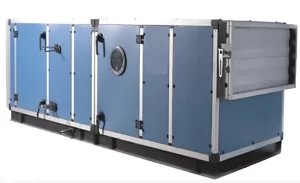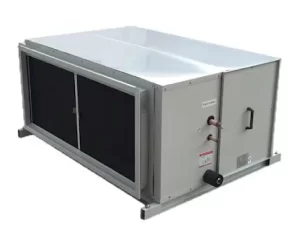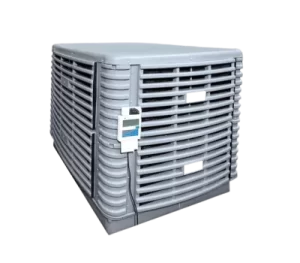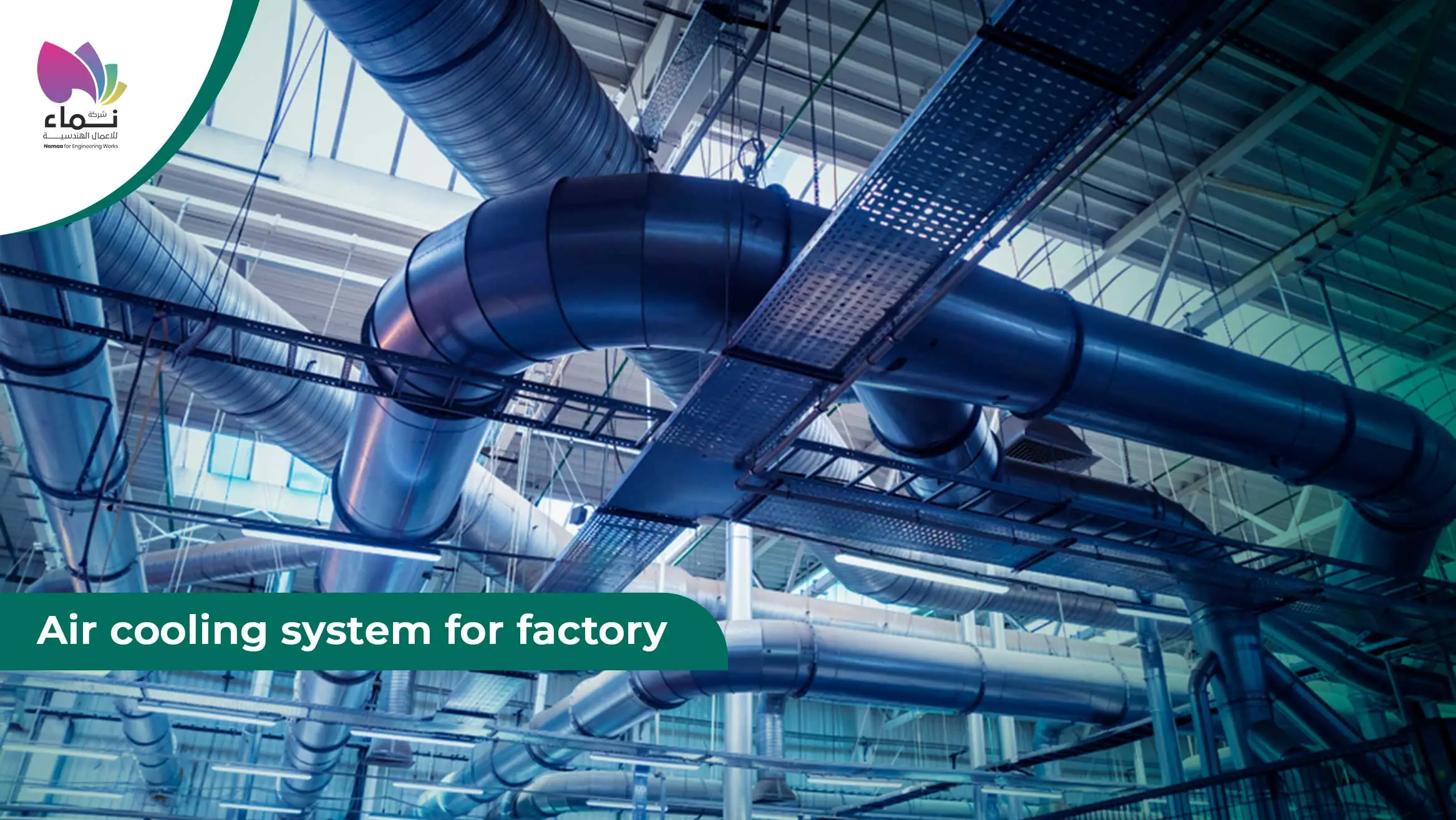air cooling system for the factory has been significantly enhanced through the collaboration with Nama Company.
This partnership has facilitated the installation of an advanced cooling system, optimizing the factory’s environmental control and ensuring optimal working conditions for employees.
Types of Air Cooling Systems for Factories
At Nama Company we understand the challenge of choosing a plant air cooling system for factory to meet your requirements.
Let us simplify your decision-making process by providing comprehensive knowledge about different air cooling options — trust Namaa to meet all your air cooling needs.
Air Handing units(AHU)
A mechanical device that conditions and distributes air throughout a building. It acts like the central hub of an air conditioning system, treating the air by filtering and removing dust, allergens, and other pollutants.
- Heating/Cooling: Coils are often used with hot water or cold water to adjust the air temperature.
- Humidification/Dehumidification: May control humidity levels in the air if necessary, AHUs do not generate cool air themselves. They rely on a separate cooling or heating source to provide conditioned water to the coils.
AHUs are versatile and can be combined with different cooling systems such as DX units or chilled water systems.

Dx Unit
A DX unit is a standalone air conditioning system that combines the functions of an AHU and a chiller into a single package.
- Evaporator coil: Where refrigerant absorbs heat from the air, causing it to cool.
- Compressor: Pressurizes the refrigerant, raising its temperature.
- Condenser coil: Releases heat from the compressed refrigerant to the outside air.
- Expansion valve: Reduces the pressure of the refrigerant, allowing it to absorb heat efficiently in the evaporator coil again.
- DX units are self-contained and easier to install than separate AHUs and chillers.
However, they may not be as flexible or scalable as AHUs for larger buildings with complex air conditioning needs.

Evaporative
An evaporative cooling system harnesses the natural process of water evaporation to cool air efficiently. Here’s how it works:
- Water distribution: Water is evenly distributed over a pad typically made of absorbent material.
- Airflow: A fan pulls warm air from the surroundings through the wet pad.
- Evaporation: As the warm air passes through the wet pad, water evaporates, absorbing heat from the air and causing it to cool down.
- Cooled air distribution: The now-cooled air is then blown into the desired area, providing a refreshing breeze.

Central Air Cooling with Direct Evaporative Cooling
When considering central air cooling with direct evaporative cooling (DEC) systems, it is important to note their effectiveness in cooling entire industrial or commercial spaces. This system works on the principle of evaporating water to cool the air, and this is done by drawing warm air through wet pads or media.
Indirect Evaporative Cooling System(IEC)
This system is characterized by the separation of air streams used for cooling and ventilation. The warm outside air undergoes cooling indirectly by passing through a heat exchanger that is cooled by evaporation.
Hybrid Air Conditioning Systems
This system offers unparalleled efficiency and versatility, making it the ideal choice for various applications worldwide. Hybrid air conditioning systems combine direct and indirect evaporative cooling technologies with traditional refrigerant-based air conditioning systems.
learn more about our product air cooling system
Benefits of Air Cooling Systems in Factories
Air cooling system for factory offer several advantages, including:
- Improved worker comfort and productivity
- Lower energy costs
- Reduced environmental impact
- Better air quality.
- Cost-effective installation and maintenance.
- Better suited for open spaces
- Climate dependence
- Temperature control
- Moisture introduction
Factors to Consider When Choosing an Air Cooling System for a Factory
When installing an air cooling system for factory, some factors must be considered when making your choice, including
- evaluate the airflow capacity of the chiller, and make sure it matches your cooling requirements by choosing a suitable size capable of handling the intended workload.
- the coolant must maintain constant temperatures, regardless of external conditions.
- determine the ease of mobility. Look for features such as wheels or handles that make it easier to transport effortlessly, especially if frequent transfers are expected.
- prioritize durability by choosing a chiller made of strong materials that can withstand harsh environments and weather conditions.
- make sure that the electric motor is of industrial grade and has sufficient power to ensure uninterrupted operation, even under heavy loads.
- take into account the number of fan blades, as a higher number usually increases the volume of airflow with lower noise levels, which enhances overall performance.
By keeping these factors in mind, you can make an informed decision and find the perfect air cooling system for factory for your specific needs and budget considerations.
Evaporative Cooling Pads
Evaporative cooling pads, also known as swamp cooler pads or cooler media, are crucial components in evaporative cooling systems. These rectangular mats are typically made of cellulose, aspen wood fiber, or synthetic fibers. They work by facilitating the process of evaporative cooling, a natural phenomenon that utilizes water evaporation to air cooling system for factory.
Air Circulation Fans for Factory Cooling
Namaa Company helps us learn about the advantages of air circulation fans to cool the factory:
These fans help reduce heat buildup and humidity levels, preventing stagnant air pockets within the factory environment.
By promoting air circulation, they help dissipate heat generated by machinery and processes, thus enhancing employee comfort and safety.
Air cooling system for factory contribute to providing cost-effective cooling solutions by improving the performance of HVAC systems and reducing energy consumption.
Industrial Air Coolers vs Traditional AC Systems
Principle of Operation
- Industrial Air Coolers: Also known as evaporative coolers or swamp coolers, they work by evaporating water to cool the air.
- Traditional AC Systems: These systems use refrigerants to cool the air.
Energy Efficiency
- Industrial Air Coolers: Generally more energy-efficient compared to traditional AC systems, especially in dry climates.
- Traditional AC Systems: Can be less energy-efficient, especially in areas with high humidity or when the system is not properly sized or maintained.
Cost
- Industrial Air Coolers: Typically cheaper to purchase and install compared to traditional AC systems.
- Traditional AC Systems: Initial purchase and installation costs are generally higher than industrial air coolers.
Maintenance
- Industrial Air Coolers: Require regular maintenance, including cleaning of water pads, changing water filters, and ensuring proper water circulation to prevent mold and bacterial growth.
- Traditional AC Systems: Also require regular maintenance, such as cleaning or replacing air filters, checking refrigerant levels, and ensuring the proper functioning of mechanical components like fans and compressors.
Humidity Control
- Industrial Air Coolers: Can increase humidity levels in the space as they add moisture to the air during the cooling process.
- Traditional AC Systems: Typically include features for dehumidification, which can help maintain comfortable humidity levels indoors.
Environmental Impact
- Industrial Air Coolers: Generally considered more environmentally friendly due to their lower energy consumption and use of water for cooling.
- Traditional AC Systems: Use refrigerants that can contribute to ozone depletion and global warming if leaked. However, newer systems use environmentally friendly refrigerants with lower environmental impact.
Suitability
- Industrial Air Coolers: Ideal for large open spaces like warehouses, factories, or outdoor areas where traditional AC systems may not be feasible or cost-effective.
- Traditional AC Systems: Better suited for enclosed spaces like offices, homes, or buildings where precise temperature control and humidity management are required.
Maintenance Tips for Factory Air Cooling Systems
Certainly! Here are some maintenance tips for air cooling system for factory:
- Regular Cleaning
- Inspect and Replace Filters
- Check for Leaks
- Monitor Refrigerant Levels
- Inspect Fan Blades
- Calibrate Thermostat
- Inspect Electrical Components
- Schedule Professional Maintenance
- Monitor Performance
Top air conditioning companies in Egypt
In Egypt, several reputable companies excel in providing top-notch air conditioning solutions. Among these, Nama stands out as one of the leading names in the industry. Renowned for its exceptional quality, innovative technologies, and reliable services, Nama consistently delivers cutting-edge air conditioning systems tailored to meet diverse needs. With a strong track record of customer satisfaction and a commitment to excellence, Namaa rightfully earns its place as one of the top air conditioning companies in Egypt.
Upgrade your air cooling system for factory with Namaa Company and enjoy unparalleled efficiency and reliability. Don’t compromise on the comfort and productivity of your workforce. Contact us today to explore our advanced cooling solutions tailored to meet your specific requirements.
FAQ
Mechanical ventilation employs fans to circulate air, either by moving it into and out of individual rooms in smaller spaces or buildings, or through a network of ducts and fans in larger buildings. This system helps maintain air quality by supplying fresh air and extracting stale air.
According to ASHRAE, ventilation standards specify the volume of air, measured in CFM (cubic feet per minute), that should be circulated per square foot per person. For warehouses, the recommended minimum ventilation rate is 0.06 CFM per square foot per person.
What are the ventilation systems in factories?
How much ventilation is required for a warehouse?




